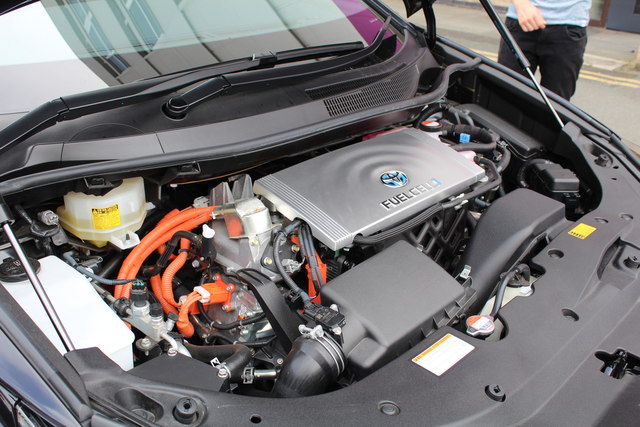The technology for remote work had existed for many years before a pandemic “forced” many industries to accept it as a norm, even if only for a period of time. This shows that even when there is a viable technology that a major event has to happen to require its adoption. The same is true of hydrogen fuel cell cars: the technology currently exists, but there are a number of obstacles to its adoption, not just in America but around the world.
What’s the Technology?
Most people are not really clear on how hydrogen fuel cell technology works. It’s not that complicated, really. Compressed hydrogen, like any other fuel, gets stored in a tank. It is then combined with oxygen from the air (which has to be filtered, cooled, and compressed before being used) to produce electricity. Water vapor is created as a byproduct. The intake system is designed to minimize noise, which you can barely hear inside the vehicle.
What’s the Infrastructure?
Fuel cells need fuel, and there are not a lot of consumer hydrogen stations in the US: in fact, all 48 of them are in California.
Hydrogen fuel stations are significantly more costly to build than conventional fuel stations, and they face the chicken and egg scenario that Tesla had to overcome of sales vs. infrastructure. Speaking of which, Musk is no fan of the technology, calling them “fool cells” and is on the record saying that with FCEVs (fuel cell electric vehicle), “success is not possible.”
What’s the Price?
Anytime a product is new in a market, it’s going to cost a lot more, because there are no economies of scale, and in the case of a new fuel, no infrastructure. Tesla is an example of a company that has addressed both issues head-on, creating a vehicle that has a base price under $50,000 and a nationwide charging network that gets larger all the time and learns from customer patterns and requests.
Hydrogen and gasoline are not like-for-like, but the best estimates price an equivalency measurement at roughly $5/$6 gallon (which isn’t that far off from what people are paying for conventional fuel these days, unfortunately). In any case, companies like Toyota, who produces the Mirai, are subsidizing this cost by giving a prepaid card to each buyer, good for three years.
The only companies making FCEVs for consumers at the moment are Toyota, with the Mirai, which we already mentioned. It has a base price at $49,000 and comes with $15,000 of prepaid hydrogen. Hyundai’s Nexo costs $59,000 and comes with $13,000 of prepaid hydrogen.
Globally the Mirai has sold only around 11,000 units (though the Nexo, at just under 10,000, isn’t too far behind) which isn’t even a drop in the water vapor bucket when you realize there are over 270M gas, diesel, and plug-in electric vehicles on the road in America.
This also means that larger commercial applications, like buses, are few in number, which isn’t helped by the fact that an FCEV (fuel cell electric vehicle) bus costs $1.2M, compared to $250,000 for gas, $300,000 for natural gas, or sounds-like-a-bargain-in-comparison plug-in electric at $500-$800k.
In a certain sense, it doesn’t really matter if FCEVs end up getting widespread adoption. Just by existing and being sold, they are proving that there are many solutions to the question of transportation and fuel, and what is missing isn’t the brainpower to come up with creative solutions. What is missing is what consumers will choose for their own future, and at the moment, that’s still anyone’s guess.
Photo of Mirai fuel cell engine courtesy of cc-by-sa/2.0 – © Richard Hoare – geograph.org.uk/p/5507847



